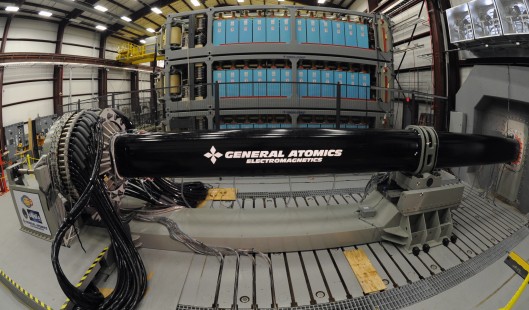US Navy announces sea trials for electromagnetic railgun
By David Szondy
April 20, 2014
Artist's concept of a ship equipped with a railgun turret (Image: US Navy)
Watching old war movies, we expect firing a navy gun to be accompanied by a deafening bang and a dramatic cloud of burnt powder. This being the 21st century, the US Navy has other ideas as it prepares to install and test a prototype electromagnetic railgun on a Spearhead-class joint high speed vessel (JHSV) in 2016 as part of a program to develop the naval artillery of the future.
Modern missiles are miracles of range, accuracy and lethality, but they are also incredibly complex and expensive with a single shot costing millions of dollars. Old-fashioned projectile weapons are cheaper, but also much less effective. They have shorter ranges, less accuracy, and still need dangerous-to-handle propellants to fire them. According to the US navy, what is needed is something with an effectiveness comparable to that of a missile, but with costs per round less than that of conventional naval artillery.
This is where the EM railgun comes in. It uses electromagnetic force to propel a warhead instead of a chemical propellant. The idea has been around since at least the 1920s and the principle has been suggested and even experimented with for every application from sidearms to levitating trains to moving asteroids, but itís only been in recent years that the principle has moved from proposition to practicality.
The EM railgun is basically an electric motor thatís been folded out and laid flat. Like an electric motor, the railgun uses an alternating electromagnetic field to pull along an armature. In this case, the armature is a sliding metal conductor that holds a projectile and is held between two conductive rails. Instead of whizzing around in a circle as in a motor, the electromagnetic field shoots the armature along the length of the rails, building up to hypersonic speeds. When it reaches the end of the rail, the armature releases the projectile, which flies toward its target.
The stats for such a weapon are impressive the current prototypes built by companies such as General atomics and BAE Systems can fire an aerodynamic shell at speeds of Mach 7.5 (5,700 mph / 9,200 km/h), which can reach the horizon in 6 seconds and has much greater range than conventional guns, having a reach of 110 nautical miles (126 mi / 203 km). Furthermore, the projectile has so much kinetic energy that it doesnít need to carry high explosives to destroy its target.
One particular advantage of the EM railgun is that it costs orders of magnitudes less than conventional missile systems. This doesn't just keep the bean counters happy, it also makes the enemy unhappy because while theyíre lobbing missiles at a million dollars a round, the railgun is shooting back at only a few thousand dollars per round. That means a lot more firepower available to commanders, and thus more flexibility in how to respond to threats, with the Navy saying that railguns would be effective against against enemy warships, small boats, aircraft, missiles and land-based targets.
The 2016 test deployment will be the first sea trial of a railgun. It will use a JHSV vessel because its cargo space and topside are readily available for installing the gun, and since the JHSV is a non-combatant ship, a permanent weapon installation isnít required.
The prototype EM railgun is the result of testing and the development by the US Navy and private companies since 2005 at the Naval Surface Warfare Center in Dahlgren, Virginia, and the Naval Research Lab. Phase I of the program concentrated on developing a 32 megajoule muzzle energy proof-of-concept weapon and a 100-nautical mile projectile. Phase II, currently under way, concentrates on making the EM railgun fire at 10-rounds per minute and being able to handle the heat and stresses of rapid firing.
The plan is to design projectiles for the railgun that will be compatible with powder guns, so a future deployment will be easier and allow missiles to be saved for major threats. Based on the success of the tests, the Navy will eventually decide on which class of ships to deploy the EM railguns.
The video below shows a railgun in action.
Source: US Navy
copyright © Gizmag 2003 - 2014
http://www.gizmag.com/us-navy-electromagnetic-railgun-sea-trials/31551

